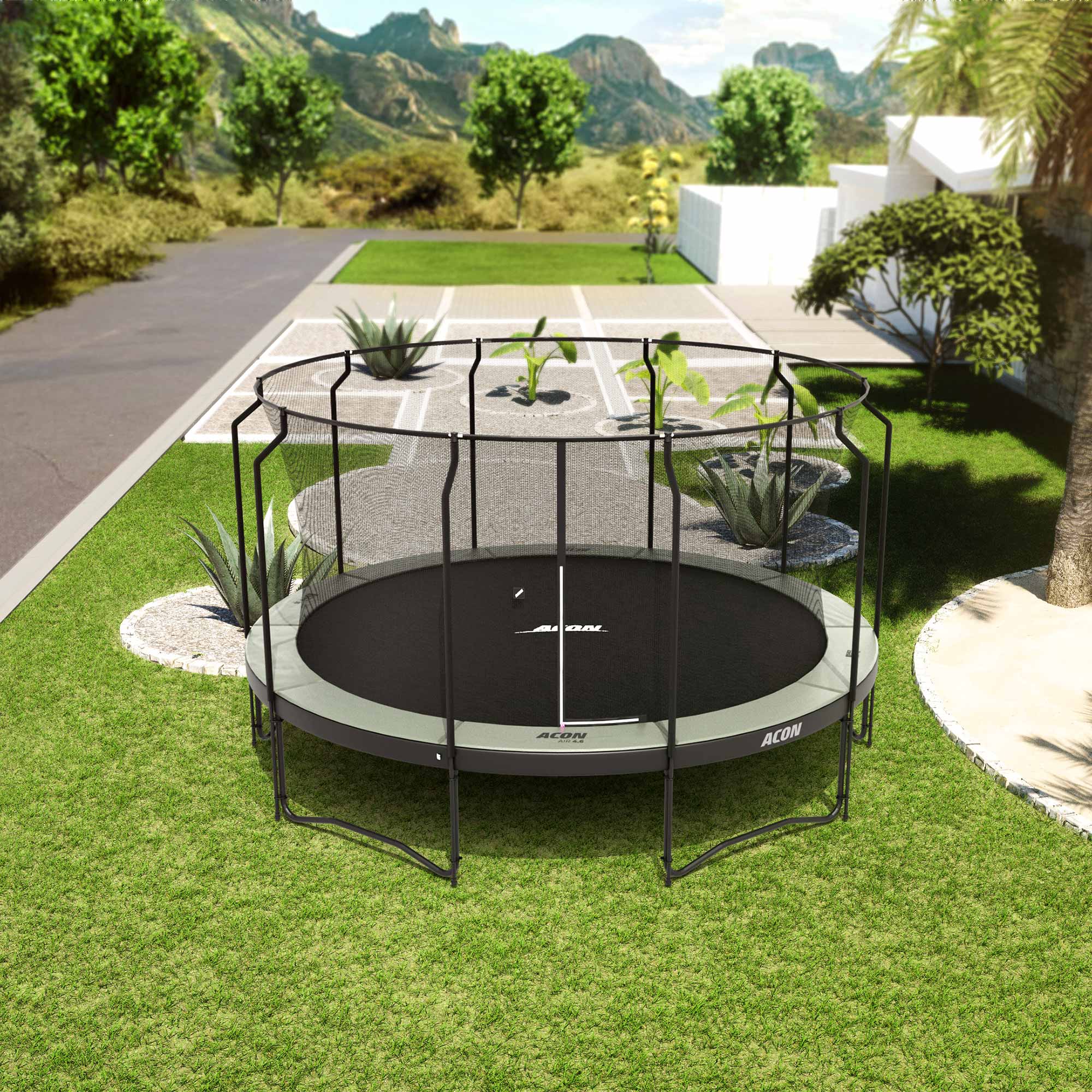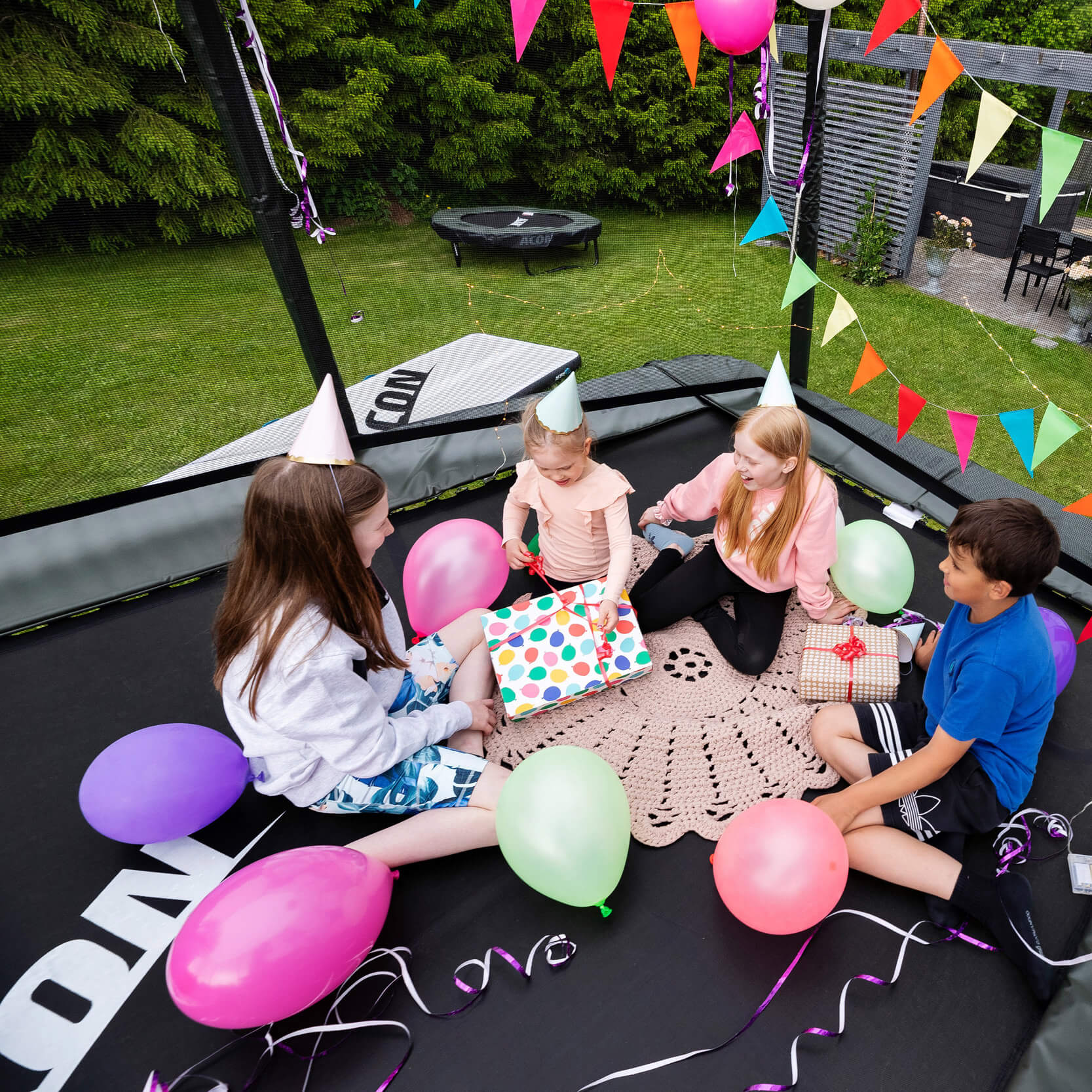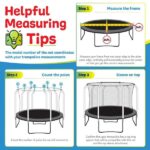Place rubber mulch, sand, or wood chips under a trampoline for safe and aesthetic base options. Couple these with strategic landscaping like ground cover plants or grass to enhance the appearance.
Choosing the right material for your trampoline base is essential for safety and aesthetic appeal. Many homeowners prioritize the use of impact-absorbing substances, like rubber mulch or sand, that provide a cushion for jumpers in case of falls. Wood chips offer a natural look and are also a popular choice, capable of blending seamlessly with your garden while still providing a soft landing.
Beyond safety, consider incorporating landscaping elements around your trampoline to create a visually appealing and functional backyard space. Grass can act as a smooth transition from play areas to relaxation zones, while low-maintenance groundcovers add greenery and prevent erosion with minimal upkeep. Selecting the best base material and landscaping design not only ensures safety but also enhances your outdoor living space.
Importance Of A Solid Trampoline Base
A solid trampoline base is critical for any backyard setup. It ensures the longevity of the trampoline and safety of the users. This foundation impacts every bounce and affects the experience. Let’s dive into why a sturdy base is essential and how to maintain one.
Ensuring Safety And Stability
Trampolines need a level and firm base to prevent accidents. Uneven surfaces can lead to a trampoline tipping over or moving around during use.
- Prevents shifting: A solid base keeps the trampoline stationary.
- Avoids uneven bouncing: Ensures uniform bounce for users.
- Reduces accident risk: Stable bases lower the chances of injury.
Maximizing Trampoline Longevity
The right base extends a trampoline’s lifespan.
- Avoids wear: Reduces stress on the frame and springs.
- Mitigates rust: Prevents water accumulation that causes corrosion.
- Enhances performance: Maintains the ideal level of tension in the jumping surface.

Credit: www.jumpsport.com
Ideal Materials For Trampoline Base
Choosing the right base for your trampoline ensures safety and longevity. An ideal base combines firmness with shock absorption. Not all materials suit every yard. Still, with various options available, you can find the perfect foundation for bouncing fun.
Crushed Stone And Gravel Options
Crushed stone and gravel serve as great choices for a trampoline base. They provide solid, level ground needed for stability. A layer of these materials can also improve drainage, reducing the risk of rust and frame damage. Keep these points in mind:
- Choose the right size: Medium-sized gravel works best as it’s easy to level and stable enough for the trampoline frame.
- Depth matters: Aim for a 4-6 inch deep gravel base to ensure proper drainage and solidity.
- Regular checks: Inspect the gravel regularly to maintain an even surface under your trampoline.
Use Of Sand For Leveling
Sand is another excellent choice for a base under trampolines. Its compact nature forms a level plane, important for safe trampoline use. Follow these tips:
- Wet and compact: Dampen the sand before compacting for better solidity.
- Maintenance: Smooth out any dips as they develop over time to keep the surface even.
Rubber Mulch For Impact Absorption
Rubber mulch is not just for playgrounds. It’s a superb option for trampolines too. Its elasticity absorbs impact, which is gentle on joints during jumps. Take note of the following:
- Thickness counts: For the best shock absorption, a layer of rubber mulch should be at least 3 inches thick.
- Containment: To keep mulch in place, use a border around the trampoline area.
- Non-toxic varieties: Ensure the rubber mulch is free from harmful chemicals for a safer bouncing zone.
Incorporating Landscaping Around Your Trampoline
To make your trampoline blend beautifully into your yard, consider the landscaping around it. Not only will this enhance the visual appeal, but it can also improve safety and accessibility.
Choosing The Right Plants
When selecting plants for around your trampoline, look for these features:
- Soft foliage – reduces injury risk.
- Non-invasive roots – protects the trampoline structure.
- Drought-resistant – less maintenance.
Consider shrubs like boxwood or ornamental grasses for a lush, low-maintenance border.
Incorporating Borders And Edging
Edging serves two primary purposes:
- Safety – defines the trampoline’s boundary.
- Design – complements your garden style.
For edging, use items like pavers or rubber mulch. These create a clear, soft edge while adding aesthetic value. For safety, ensure the materials are foot-friendly and non-slip.
Optimizing Drainage With Proper Planting
Good drainage is vital for plant health and trampoline longevity.
- Choose plants that absorb excess water.
- Install a slight slope away from the trampoline.
- Consider a French drain if needed.
This setup ensures water flows away, keeping plants happy and your trampoline area dry!

Credit: us.acon24.com
Creative Ideas To Enhance The Trampoline Base
Setting up a trampoline in your backyard stands as a beacon of fun and excitement. Choosing the right base not only adds to the safety but can transform the area aesthetically. Here are some creative trampoline base ideas paired with landscaping tips to make your trampoline area a sight to behold.
Artificial Grass For A Natural Look
Artificial grass is a stellar choice for those seeking a natural vibe without the upkeep. It offers:
- Soft landing for jumpers.
- Low maintenance; no mowing or watering.
- Durability through all seasons.
Install artificial turf around your trampoline. It will blend seamlessly with your garden and require minimal effort to maintain.
Play Areas With Bark Chippings
Bark chippings are incredible for play areas. These organic materials give off a rustic charm and benefit your garden soil in the long run. When used under trampolines, they provide:
- Cushioning for accidental falls.
- Natural weed suppression.
- A pleasant underfoot texture.
Use Of Paving Stones For Pathways
| Advantages of Paving Stones | Landscaping Tips |
|---|---|
| Defined pathways to the trampoline. | Combine with creeping plants for a charming trail. |
| Durable surfaces for high foot traffic. | Space out the stones to encourage grass growth. |
| Customizable patterns to fit your style. | Use varied stone colors for a unique design. |
Adding paving stones creates ordered beauty and directs traffic effectively. Lay them down to build inviting paths leading to your fun zone!
Diy Landscaping Vs. Professional Assistance
Deciding on the perfect base for your trampoline involves both design and safety considerations. Some may feel confident in their ability to tackle landscaping projects, while others prefer to call in the experts. Let’s explore whether it’s best to put those gardening gloves on or to dial up the professionals.
Assessing Your Landscaping Skills
Analyze your skill set before diving into a trampoline base project. Start with these questions:
- Have you completed similar projects?
- Do you understand the materials required?
- Are you aware of potential challenges?
Simple landscaping tasks could include:
- Laying down rubber mulch
- Installing a weed barrier
- Setting up garden border pavers
If you’re comfortable with these tasks, a DIY approach could work.
When To Call In The Pros
Sometimes, the expertise of a professional is invaluable. Consider calling in the pros if:
- You need extensive ground leveling.
- Drainage issues in your yard could affect the trampoline.
- Garden beds or complex designs are part of your plan.
| Task | DIY | Professional |
|---|---|---|
| Ground Leveling | Basic leveling can be DIY. | Extensive work needs pros. |
| Drainage Solutions | Simple fixes possible. | For major issues, hire help. |
| Design Implementation | Suitable for green thumbs. | Ideal for elaborate plans. |
Remember, safety comes first. Professional landscaping ensures a safe and sturdy trampoline base.
Maintaining Your Trampoline And Surrounding Landscape
Maintaining Your Trampoline and Surrounding Landscape ensures the safety and aesthetic appeal of your outdoor enjoyment area. Over time, the base beneath your trampoline requires attention, just as the surrounding garden does with the change of seasons. Simple, regular maintenance not only prolongs the life of your trampoline but also keeps the garden looking vibrant. Follow these essential tips to protect your investment and keep your backyard looking its best.
Regular Base Checks And Top-ups
The foundation of a great trampoline experience is a solid base. Set a schedule to regularly inspect the area under your trampoline. Look for any signs of erosion or unevenness that could lead to instability. Using the right material for base top-ups is crucial to maintain the perfect bounce and safety. Here are some base materials recommended:
- Rubber Mulch: A popular choice for its shock absorbency.
- Sand: Helps with drainage while providing a solid base.
- Wood Chips: Inexpensive and easy to spread, ideal for a natural look.
Seasonal Care For Your Landscaping
As the seasons change, so should your landscaping care. Plants and trees near your trampoline can be affected by the shade it casts, so consider seasonal pruning to ensure they get enough light. In autumn, remove fallen leaves to prevent them from accumulating under the trampoline. This minimizes moisture and mold growth. In spring, add seasonal blooms to the landscape for a vibrant touch.
Cleaning And Protecting Your Trampoline
A clean trampoline is a happy trampoline. Regularly sweeping off leaves, dirt, and debris will help to prevent damage to the jumping mat. Use mild soap and a soft brush for a thorough clean. For protection, consider a weather-resistant cover to shield your trampoline from rain and UV rays. This simple step can significantly extend the life of your trampoline.

Credit: us.acon24.com
Frequently Asked Questions Of What To Put Under A Trampoline: Best Trampoline Base Ideas With Landscaping Tips!
What Materials Work Best Under A Trampoline?
Rubber mulch, sand, or play bark are excellent materials for trampoline bases. They offer good drainage, impact absorption, and are gentler on the feet. These options are also aesthetically pleasing and blend well with landscaping attempts.
How Does Landscaping Enhance Trampoline Safety?
Landscaping can provide a soft perimeter and help integrate the trampoline with your yard. Planting shrubs or flowers around the trampoline reduces the visual impact while also offering a cushioned boundary, which can be safer for users.
Are There Creative Ways To Landscape Around A Trampoline?
Yes, consider adding a garden bed, small bushes, or ornamental grasses around the trampoline. This not only hides the legs and framing but also creates a pleasant play area. Ensure plants are soft and non-invasive to maintain safety.
Can Installing A Trampoline Affect Lawn Health?
Without proper care, a trampoline can impede sunlight and water, affecting grass health. A breathable base or periodic moving of the trampoline can help mitigate this issue, preserving the underlying lawn.
Conclusion
Wrapping up, selecting the right base for your trampoline enhances safety and aesthetics. Whether it’s rubber mulch, sand, or garden landscaping, thoughtful planning pays off. Keep these insights in mind for a stunning, secure yard where memories will soar. Leap into landscaping with confidence and creativity!
